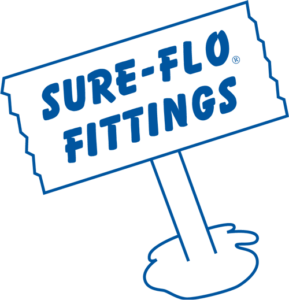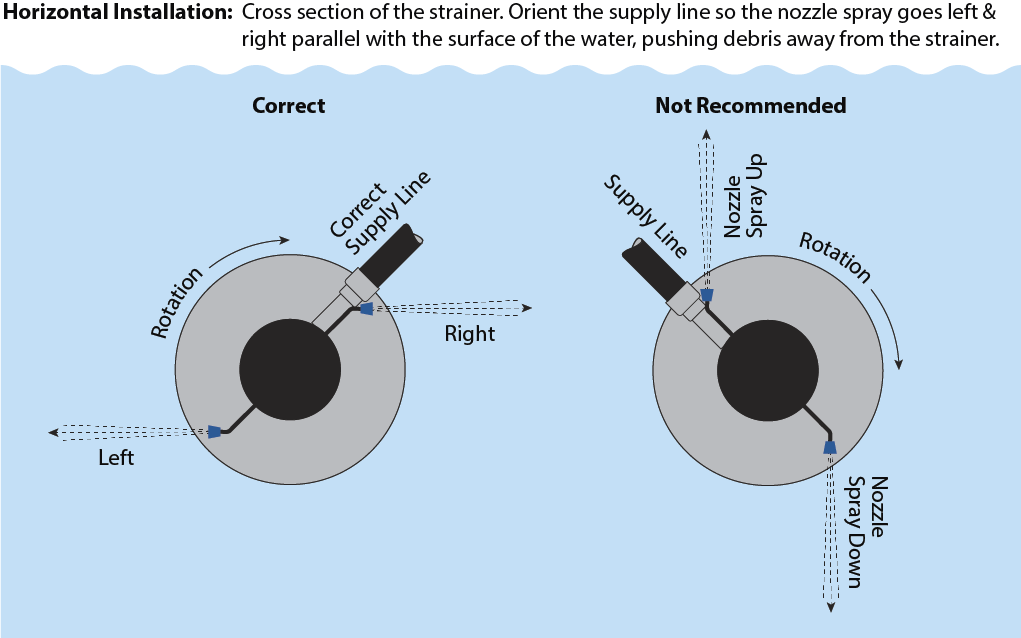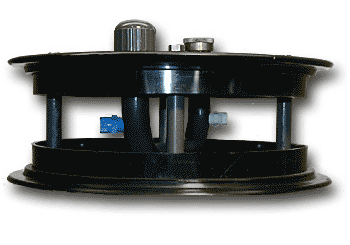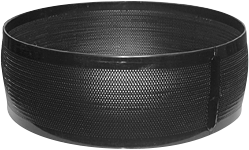FAQs
Foot Valves
How does it work?
A rubber flapper gasket inside the foot valve swings open and out of the flow while pumping. When pumping stops, the flapper swings shut and closes the foot valve. There are no springs. The water column itself provides the pressure on the flapper, which in turn seals the valve. A steel disk on each side of the flapper holds the flapper in the proper position.
How much head does it take to seal?
We recommend a minimum of 4 feet of static head ( a vertical distance measured from the pump centerline to the surface of the water source) in order to properly seal the valve.
How do I attach it?
Sure-Flo foot valves are available in three attachment styles.
- The standard OD tubing valve utilizes a ring gasket and flange to make a compression seal. These valves are designed to be used on OD tubing dimensions only and will not fit on IPS pipe or PVC pipe.
- Threaded foot valves have an IPS female thread attachment.
- Companion flange foot valves will attach to any standard 125-pound cast iron flange or schedule 80 PVC companion flange.
What position should I install it in?
All Sure-Flo foot valves have a hump cavity designed into the body casting. This hump allows the flapper to get out of the water flow and reduce friction loss. This hump also locates the flapper hinge area. When installing the foot valve, it is important that this hump be located in the uppermost position.
It’s hard to pull the suction line out, is there any way to drain the suction line?
All foot valves, 4″ and larger, have a tapped 1/2″ FPT outlet on the side of the valve body. This outlet is plugged with a 1/2″ pipe plug before leaving the factory. A simple method for draining the suction line is as follows:
- Remove the original 1/2″ pipe plug.
- Replace with a 1/2″ NPT X 5/8″ garden hose adapter (available from Sure-Flo)
- Attach an inexpensive hose of sufficient length to reach from the foot valve to the pump and tie the hose so it can be reached to later drain the suction line.
- Tightly place a hose cap on the pump end of the hose to maintain the suction vacuum while pumping.
- When you need to drain the suction line, remove the hose cap and place the hose end at the water level. This will allow the suction line to drain down to the level of the water source.
My water has a lot of debris; can I get a larger screen?
There are several alternatives to the standard foot valves strainer, which provide greater screening areas.
- X Series- 2 inch through 6 inch foot valves are available in the X series. These valves are outfitted with a larger diameter seat ring casting, bottom disk casting and a longer and thicker screen. 1/8″ perforations are standard for this series.
- J Series- 4 inch through 10 inch foot valves are available in the J series. All J series screens are 18″ in height and 13.5″ in diameter. This series is also available in a double-decked configuration which provides a screened height of 36″
- XL Series- 6″, 8″, and 10″ foot valves are available in the XL series. The XL screen is 36″ in height and 22.5″ in diameter. This is the standard screen for the 12″ foot valve.
- Self-cleaning strainers- All Sure-Flo foot valves can easily be modified to attach to Sure-Flo self-cleaning strainers.
What options are available?
Standard Sure-Flo foot valves are built with plated or zinc coated steel nuts and bolts. Stainless steel nuts and bolts are available as an option.
The standard Sure-Flo foot valve screen is .050″ thick with 1/4″ perforations. Thicker screens .080 are available for regular foot valves and are standard for the X and J series. 1/8″, 1/4″, and 1/2″ perforations are available for most foot valves. J series and Xl series are also available with 1″ perforations .125″ thick. In addition, the J series is available with 3/4″ perforations .125″ thick.
A stainless steel, 16 gauge, 1/4″ perforation screen is available for the foot valves. Stainless steel 1/8″ perforations are available for the J-series.
Self-Cleaning Strainers
How do they work?
A small portion (typically, less than 4%) of the pressurized pump discharge is returned back to the strainer through suitably sized hose or piping. This pressurized water is distributed to a series of specially designed internal nozzles. As this water is sprayed outward through the screen at a designed angle, it continually rotates the screen and any debris attracted to the strainer is blown off as it passes in front of the nozzles and is pushed away from the suction line.
How do I attach it?
The strainer neck is standard PVC pipe, tapped and provided with a series of stainless steel set screws. If the suction line is aluminum OD tube, it can be inserted into the PVC neck and the set screws tightened to secure it. Since the neck is standard PVC, an assorted choice of PVC fittings (couplers, threaded adapters, Van-Stone companion flanges, etc.) can be installed to attach the strainer to a wide range of suction lines. Caution: To facilitate future servicing of the strainer, never cement the strainer to the suction line. Instead, drill and bolt the fitting in place.
What do I need to make it work?
- An outlet on the discharge line from the pump.
- A supply line of sufficient size (refer to the strainer literature) from the pump discharge back to the strainer.
- A method of supporting the suction line so that the strainer is held up off the bottom and is free to rotate.
Why do I need a gate valve on my discharge line?
A discharge gate valve allows the pump to provide the pressurized discharge water required by the strainer. Partially close the discharge valve to build pressure while filling discharge lines. Without this valve, during the startup and line filling phase, the strainer could become clogged and without the pressurized spray, be unable to clean itself. Once the lines are filled and full pressure is developed, the valve can be fully opened to allow the desired flow.
How often does it clean?
The strainer is designed to operate continuously during the pumping cycle. Whenever the pump is drawing water the strainer should be cleaning. Intermittent cleaning is not recommended.
Can I use a foot valve with it?
Yes, the standard screen on Sure-Flo foot valves is replaced with a socket to accept the strainers PVC main suction tube.
Should I use a filter on the backwash line?
If the proper precautions are taken during installation (flushing the pump and supply line) a supply line filter is not required. Particles which can pass through the self-cleaning strainer’s screen are too small to clog the nozzles. If you choose to use a supply line filter, be sure to use a mesh that is larger than the self-cleaner mesh. Otherwise, the supply filter can quickly clog and fail to provide the self-cleaner with the pressurized water it requires for proper operation.
How fast does it rotate?
This varies, depending upon operating pressure and the strainer model. Typical rotation speeds range from 12 to 15 revolutions per minute.
Why does the screen rotate instead of the spray?
A very deliberate design feature, with stationary nozzles a constant directional spray is created, producing a fairly strong current away from the strainer. Clogging debris is blown off the screen and is pushed away (20 to 30 feet in many cases) to prevent being reattracted to the strainer. If the spray is rotating, while able to blow off the screen, debris is just reattracted by the suction line.
What’s the reason for the different size holes in the center main suction tube?
The graduated hole sizing in the internal suction tube is the secret to the Sure-Flo self-cleaning strainer’s uniform flow from top to bottom of the screen. The holes are smaller closer to the pump to restrict some of the water and are larger further away from the pump to even the draw across the height of the cylinder. Without this hole pattern a “hotspot” is created at the top of the screen, common with most other self-cleaners. The Sure-Flo strainer is more resistant to clogging and easier to clean.
What screen options are available?
The standard screen is a powder epoxy coated, aluminum, .080 thick with 3/16″ perforations. For finer filtration, this screen can be covered with either an 18 or 32 mesh stainless steel mesh. A 16 gauge, 316 stainless, perforated screen with .117″ perforation is also available.
How do you determine the rated capacities?
Maximum rated capacities (for single drive models) are based on a through screen velocity of .5 feet per second. This low rate of flow reduces debris attraction and is easily cleaned. In conjunction with the uniform top to bottom attraction, these factors make the Sure-Flo self-cleaning strainers a great choice for areas with state or federal regulations, concerned with fish protection. Local requirements may vary.
What’s the difference between a regular model and a dual drive model?
For applications with insufficient pressure to operate the strainers, Sure-Flo created the dual drive series. Identical to the regular strainer with an additional set of cleaning nozzles located 180 degrees from the primary nozzles. Although these strainers require more gallons of cleaning water, they can operate at lower pressures. Since the screen is cleaned twice per revolution, the dual drive models have become popular for applications in very heavy debris sources, even when higher pressure is available.
Can I use higher pressures than those recommended?
Sure-Flo self-cleaning strainers can safely handle pressures much higher than their required minimum pressure. Generally, the use of slightly higher pressures will provide improved cleaning action. Pressures above 70 PSI usually produce no additional benefits and lead to premature wear.
What if a nozzle gets plugged?
In the unlikely event of a clogged nozzle, access to the inside of the strainer is simple. Remove the outer circle of nuts from the bottom of the strainer. Remove the bottom outer plastic disk. The screen is now easily removed from the strainer.





